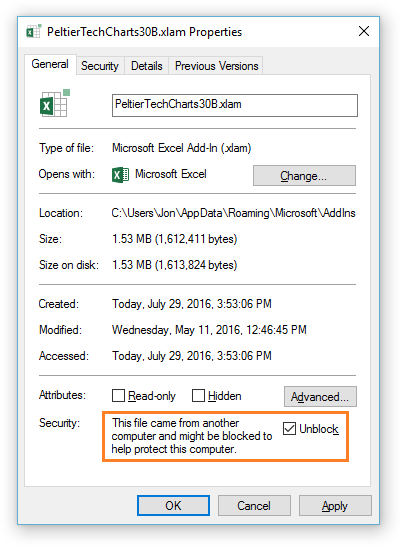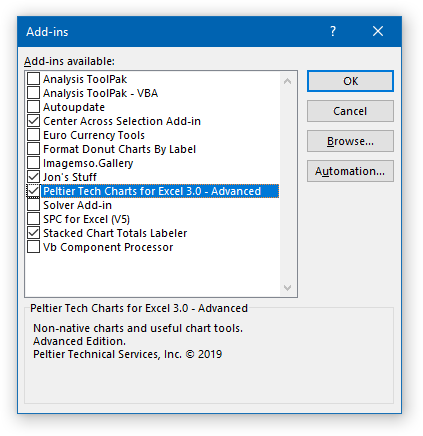A lot of Excel procedures are packaged in Add-Ins. An Add-In is basically a workbook containing some code, that has some other unique properties. An add-in usually has some user interface elements, such as buttons on the ribbon or on context (right-click) menus, so you can access its features.
The add-in workbook itself is invisible, though it has one and often more hidden worksheets, where information related to the add-in may be stored. The add-in can be installed, which means it opens every time Excel opens, so that its functionality is always available. An Excel add-in can also be opened like a regular file when you need it, without installing it, though it is still hidden.
Preparing to Install the Add-In
Very often, an Excel add-in is packaged in a zip file. Unzip the file, and store the add-in in the User Add-in Library, which is
C:\Users\USERNAME\AppData\Roaming\Microsoft\AddIns\where USERNAME is your Windows login. You can get there quickly by pressing Win+R (Win = Windows key), typing %appdata% in the Run box, and clicking OK (which opens the Roaming directory), and drilling down to Microsoft and then AddIns.
You can actually store the add-in in almost any convenient folder, but when you use the Add-In Library, it’s easy to find the add-in from within Excel when you install it.
Windows protects your computer from malicious software that came from a different computer than yours, but it also protects your computer from useful software that comes from my computer, so you need to unblock the add-in. Right click on the add-in file in Windows Explorer, and choose Properties. At the bottom of the General tab of the Properties dialog, there may be a notice that the file may be blocked, and there is a checkbox to unblock the file. (Below is the dialog for Peltier Tech Charts for Excel, my commercial Excel charting add-in.)

Check the Unblock box, and click OK.
Installing the Add-In
If you have the Developer tab showing on Excel’s ribbon, go there and click on Excel Add-Ins (or if it’s an older version of Excel that has no Excel Add-Ins button, click on Add-Ins) to open the Add-Ins dialog.
Otherwise, click on the File tab > Options > Add-Ins. Click the Go button near the bottom of the list to open the Add-Ins dialog.
Or you can use the old Excel 2003 shortcut, Alt+T+I, to open the Add-Ins dialog.

If you stored the add-in in the User Library, it will appear by name in the Add-Ins dialog. Otherwise you will have to click Browse, then navigate to find the add-in.
Check the box in front of this entry, then click OK, and the add-in is installed, available whenever you run Excel.
Uninstalling an Excel Add-In
Follow the steps to get to the Add-Ins dialog (Developer tab > Excel Add-Ins, File tab > Options > Add-Ins > Go, or Alt+T+I). When the Add-Ins dialog opens, locate the add-in in the list, uncheck the box in front of it, and click OK. The add-in should remain in the list, to make it easy to reinstall at some future time.
Using an Excel Add-In without Installing
If you don’t want an Excel add-in installed all the time, you can simply start it when you need it, using File > Open in Excel, double clicking on the add-in file in Windows Explorer, or dragging it from Windows Explorer and dropping it on Excel.
Note that the add-in must be unblocked before opening it in Excel. When a regular workbook is blocked, it will open in Excel in a Protected Mode window, and it cannot be edited. An add-in does not open in a window, so a blocked add-in will simply not load. Follow the steps to unblock the add-in, and it will load just fine.
Install an Excel Add-In in Excel for Mac
The protocol to install an add-in on the Mac are similar. Visit Install an Excel Add-In in Excel for Mac to read the specifics.



Murat says
We encountered a case when our XLL file is getting blocked, while not being present in the list of disabled items of Excel, and it doesn’t show as blocked in the file properties. It seems that the file is being blocked by its name. When you re-name the file, it starts working fine (connects to Excel). However, if you move it to another folder (without renaming), it remains blocked.
Does anyone have any ideas on how to unblock the XLL in such cases?
Darin Brannan, MD says
I have tried to install the Growth.xla in both PC and MAC environments without success. I am receiving a “Compile error in hidden module: Growth”. I am using 2010 vs of Excel on PC (Exchange environment) and v16 on macOS (non-Exchange environment). Does anyone have a solution for this?
Jon Peltier says
Darin –
According to the web site, GROWTH.xla is an old add-in, written in Excel 2000. The VBA itself is probably okay, though it was probably written by a scientist rather than by an Excel/VBA professional. The most common reason for this kind of error is that the code calls the 32-bit version of a Windows API. Excel 2010 introduced a 64-bit option, and we’ve developed ways to call 32- or 64-bit APIs depending on the version of Excel which is running. Also, if you try to open their PC version of the add-in on a Mac, the Windows API will cause that error.
You could try to open the add-in on a 32-bit version of Excel, or you could contact the authors of the software to see whether they have an updated version (the data used by the add-in is also as old as the add-in) or whether they have plans to update it. Or would they be receptive to having an Excel/VBA professional (like me) update it for them.
jdgrapes says
I have tried to install this, I followed the installation guide lines but can’t seem to see it, I’m running Win 10 and MS Office 2019.
Any ideas please
Many Thanks
Jon Peltier says
What add-in are you trying to install? Have you unblocked the add-in workbook?
Sultana Joe says
Hi Jon,
Been trying to install XL2BB, I gone over the install instructions again; I can’t see the file being downloaded for some reason. All of the MS Add ins seems and are installed,.If it has been downloaded not sure were it is being stored.
Many Thanks
Best Regards
jdgrapes
Jon Peltier says
Hi Joe –
You need to download the XL2BB add-in. It probably is downloaded to a folder called Downloads.
The XL2BB.xlam add-in is packaged in a zip file, so you have to unzip it before trying to install it. While you’re at it, store it in a convenient location, like
C:\Users\USERNAME\AppData\Roaming\Microsoft\AddIns\.Then unblock the add-in file: right click on XL2BB.xlam, choose Properties, check the Unblock box, and click OK.
Now follow the rest of the protocol.
Sultana Joe says
Hi Jon,
Got it, Man
Thanks Again
Antonio says
Once downloaded how do I get to run it from the ribbon? it doesn’t show on my ribbon and I tried adding a new tab and new group but couldn’t find an option to add this adding to the new group :(
loved256 says
I installed it as you but its just rotating not opening at all
Jon Peltier says
What is the add-in?
What do you mean ‘rotating’? The blue Windows donut?
Did you unblock the add-in file before installing it?